| |

Home
Thousands of tastings,
all the music,
all the rambligs
and all the fun
(hopefully!)



Whiskyfun.com
Guaranteed ad-free
copyright 2002-2023
|
 |
|
| Hi, this is one of our (almost) daily tastings. Santé! |
| |
|
| |
| |
November 18, 2023 |
|
  |
|
Angus's Corner
From our correspondent and skilled taster
Angus MacRaild, this time in Alsace.
Assistant taster for this session: Serge
The Latest News In
Old Style Whisky
A D-Day Special!
|
 |
|
|
It's D-day! Which is to say, Distillation Day at Whiskyfun HQ in Turckheim. This year it's Mirabelle and gin which will be going into the mighty wee alambic still. Thank goodness the gin market is still booming so vigorously. |
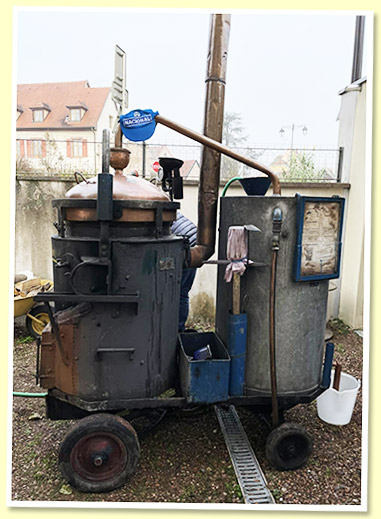
Ultra-modern and used for about thirty years
to
produce the world's finest spirits.
At Whiskyfun, we know what we're talking about!
|
|
|
This was also a good opportunity for Serge and I to sit down together and taste some very special spirits, not least this recently discovered 1833 Blair Castle whisky. In my view this is one of the most exciting discoveries in whisky, ever. You wait your whole life for early 19th century, illicit still malt whisky to turn up, then 40 bottles come along at once. |
|
|
To give a little background on these bottles. The whisky was known about by the family but hadn't been looked at for many years. The bottles were found while clearing out one of the cellars at Blair Castle, apparently sitting behind some very knackered old bottles of Sloe Gin, with a wooden shelf plaque which stated: 'Whiskey small still, Distilled: 1833, Bottled: 1841, Re-bottled: 1932'. The family contacted Whisky Auctioneer and decided to sell 24 of these bottles and keep the others. |
|
|
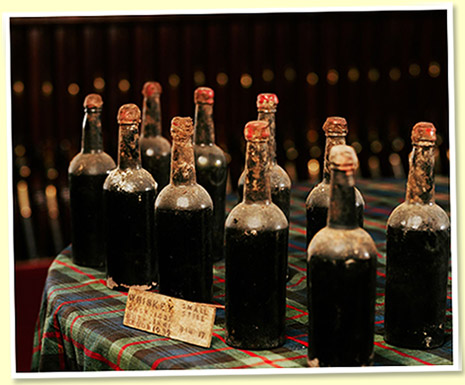
|
|
|
There is not sufficiently concrete information to confirm those distillation and bottling dates, but the cellar records from 1834 indicate '40 gallons of whiskey in cask' as being contained within Bin 65 in the cellar. There's also written evidence of spirit bottling taking place at the estate household in 1841 when 'four-dozen' bottles of brandy were filled. In addition, the estate archives contain physical items related to and numerous references to distilling on the estate during the early 19th century, in particular the letters between tenants and factors which reference this activity. |
|
|
Thanks to the fact that more than one of these bottles was able to be opened, some chemical analysis was undertaken on the whisky by the Scotch Whisky Research Institute in Edinburgh using gas chromatography. This analysis was able to confirm it was likely to be malt whisky made in accordance with our understanding of practices of the time, and that it had been aged in a cask made of oak.
Given the time period, there aren't too many 'official' distilleries this could have come from, operational licensed distilleries on the estate in those years would have included Edradour, and the long-closed Tullymet. But the term 'Small still' would strongly suggest it was produced by either an estate tenant, or by the estate household itself. |
|
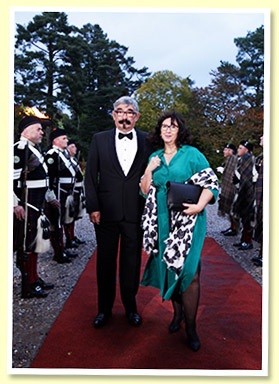
Arrival of unknown guests at a
Keepers Of The Quaich banquet, Blair Castle |
|
|
There is also the question of the 1932 re-bottling. Little is known about the storage of the whisky during the first century of its existence, other than it's likely to either have been glass or stoneware demijohns, or even older glass bottles of some sort. Having examined one of the bottles it was re-bottled into in 1932, the glass is certainly of a manufacture typical of late 19th century production, which would make sense as the cellar master would likely have had access to sufficient quantity of such bottles to make the re-bottling at that time. We also probably have this re-bottling to thank for the remarkable preservation of this whisky; the fact it has retained an ABV above 60% even after nearly two centuries is just amazing. |
|
|
It is frustrating that we cannot know more definite details, and this is a whisky that in many ways raises more questions than it answers, but the fact it exists at all is extremely special and offers us a genuine glimpse at a time when 'Scotch Whisky' was on the cusp of transition from an underground culture to a mainstream industry. |
|
|
But before we get to the Blair Castle whisky, let's first have some suitable aperitifs, followed by the most appropriate sparring partner it's probably possible to find. |
|
|
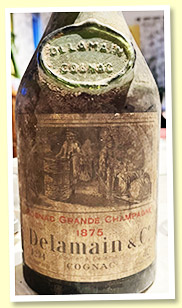 |
Delamain & Co 1875 Grande Champagne Cognac (40%, OB, -/+1960s) 
From the cellars of Château Wwhiskyfun. Probably in demijohn for many years prior to bottling . Colour: coppery bronze. Nose: very leafy and mulchy, old dark earthiness and rancio. Many tobaccos, plums soaked in Armagnac, hardwood resins, cough syrups and mothballs. Very antique and definitely 'old school' Cognac - which is to say darker, heavier, earthier and more deeply rustic, very much the pre-Phylloxera profile. In time it becomes more leathery and more outrightly herbal, a few impressions of dried out make up and face creams too, you might also say very strong 'antique dresser' vibes. |
|
|
Mouth: very thick and syrupy in the mouth, really closer to old liqueurs such as Chartreuse, Benedictine and Creme De Menthe, perhaps also some aged Drambuie with these crystallised honey, mead, dusty pollens that come through. In time there's even some waxes as well. Becomes more impressive with each sip. Still typically and charmingly of the old school. Some preserved fruits too, plums and apricots, and some crystallised ginger, again these leafy tobacco notes too. There is probably some kind of sugar / boisé added to this, but it feels rather invisible and well-integrated, you see no joined edges, just leaving this rather lovely thick and liqueurish profile. Finish: quite long, and surprisingly lemony, while there's also more familiar and deeply rustic mulchy tobacco leaf, cigar humidor, chocolate and plum liqueur. Very assuringly on rancio, rancio, rancio into the aftertaste. Comments: probably it has lost a few degrees of alcohol in the bottle, but the texture and richly earthy and rancio notes make it very satisfying and it would keep on developing with time in some very enchanting ways. We felt you could go up a point or two from 90, or down a point or two the opposite way depending on whether you chose to concentrate on its subtle flaws, or considerable charms. So our score is perhaps a little bit of a compromise, but better to celebrate beauty that criticise failings, is it not? Angus SGP: 561 - 90 points.
Serge SGP:451 - 90 points. |
|
|
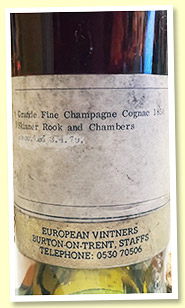 |
Grande Fine Champagne Cognac 1850 (No ABV, Skinner Rook & Chambers, bottled circa 1950)
A bottle I bought at auction some years ago and seemed a fitting occasion to open. The label states re-corked 1979. And it would appear Skinner Rook were bottlers… of beer! Or at least that seems to have been what their main business was, not at all surprising that such a company might have had their own Cognac bottling in the mid-20th century, but maybe a little surprising that it would have been an 1850 Grande Champagne cognac. Colour: deep orangey gold. Nose: stunning and incredible freshness and exuberant fruitiness! Amazing tinned peaches, lychee, also rancio but enveloped by honeys, fruit teas, very gentle wee waxy notes, brings to mind similarly ancient Glen Grants! You can also add some beautiful and rather expensive bitter orange marmalade, very old Sauternes and sweet Chenin blanc. Just terrific and so alive, we are wondering if there's any sugar been added to this one at all? Either way, a totally beautiful nose! |
|
|
Mouth: once again, amazingly all about freshness and fruits. Indeed, the ripeness of the fruit is so impeccable and amazing. You also have some stunning wee wood spices and resins, once again a suggestion of medicinal herbs such as wormwood and then a feeling of aged demerara dark rum. Also prunes and some bitter chocolate. Amazing profile, that would keep on developing and showing many small fruit flavours and additional wee complexities. Finish: good length once again, on cocoa, tobacco, miso and deeper, earthier and more rustic impressions. Comments: devastating, you could drink 50cl without leaving the table. The nose alone is 94 point territory, only a tiny softness in the finish will cap my score at…
Angus SGP: 651 - 93 points.
Serge SGP:651 – 92 points. |
|
|
The nose on the 1850 is hands down superior, but the palate of the 1875 starts to catch up. Thankfully, having full bottles in front of us, we have found a clear solution which is to blend them equally and simply drink the resulting 1862.5 vintage. |
|
|
So now, over to Scotland… |
|
|
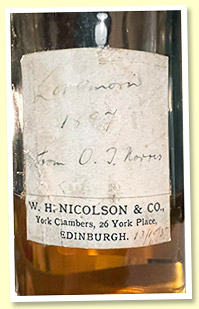 |
Longmorn 1897/1905 (58.4%, cask sample. Drawn 13/10/1905)
A cask sample that was purchased privately as part of a small bundle of such old samples, from an old lad who had worked in the industry and kept them as mementos. It was among a few other cask samples and old miniatures, most of which were out of condition. This one, however, was over three quarters full and had a small, but very well intact, and clearly very old driven cork, which helps to explain its excellent preservation. I got the ABV by using my Anton Parr electric hydrometer. There is a faint date noted in pencil on the lower part of the label, which makes sense as 'drawing' date. If it is indeed accurate, this should be pretty much the same age as the 1833 Blair Castle. I know, I know, so many assumptions at work, but we must struggle on… |
|
|
Colour: bright straw. Nose: extremely pure, fat and powerfully on distillate character. What's also totally incredible is how it would immediately reveal a familiar Longmorn fruitiness, that you'd recognise in many later bottlings from 1950s and 1960s distillates. Then also deep and almost gelatinous waxiness, mineral oils, suet, bone marrow and greasy hessian tool box rags. That also leads to metal polish, paraffin and steel wool. Astonishing power and the fact that it retains these wee fruity touches that suggest white, green and even exotic fruits is really remarkable, normally in other 'bottled' whiskies of such age all traces of fruit are usually quite suppressed. Continues with grape lees, slightly funky and sharp cider apple notes and a little menthol aspect coming through. Eventually, with quite a bit of time, it is once again converging on a spot where many ancient malts seem to alight: very old Yellow Chartreuse. With water: an impression of coastalness all of a sudden, and an even more powerful and pronounced minerality. Also underripe gooseberry, crushed nettle, banana liqueur and lanolin. In fact, globally it is getting even more medicinal. Finally some old paper parchment and inkwells. |
|
|
Mouth: like being woken up by Mike Tyson and Ozzy Osbourne. Incredible power and a massive arrive full of thick, peppery waxes, sharp and acidic white and green fruits, limestone, putty and other rather intense mineral aspects. Even also a saltiness that quickly begins to emerge, salt and lemon peels with further notes of herbal teas, herbal bitters and camphor. Even the tiniest sip fills your mouth completely. With water: astonishing, becomes even broader, fatter and sharper. More salty, vivid citric acids which sit discombobulatingly alongside the fattest of waxes, and once again more herbal liqueur vibes. I also forgot old, crystallised honey cut with sea salt, even leading to aged mead and herbal tea with runny honey. That's the trouble, there's just so much going on it starts leading you in circles. |
|
|
Finish: extremely long, and profoundly warming and peppery. All these wee flourishes of waxes, lemon rinds, pin-sharp minerals, sheep wool and more liqueurs, herbal teas, dried mint and greasy hessian. |
|
|
Comments: Hard to know what to say. By any measure an astonishing whisky and an undeniably emotional slice of liquid history. It is most fascinating and comforting that there are aspects which are familiar and suggest qualities also found in 50s and 60s Longmorns, while at the same time, there is equally an 'old style' aspect which is quite profoundly 'old, old style' and comfortable pre-war. I increasingly think that, while you can make a very clear distinction between the modern era (say 1975-present) and the whiskies of the 1940s-1960s, you can with increasing confidence say the pre-WWII era was of another style in and of itself. This certainly sits in that latter camp and is very much an example of historic whisky making that belongs to the Victorian era and does not presently exist in Scotland, or anywhere for that matter. This is not a flavour profile that you can access anywhere in my knowledge. It is so profoundly about texture and power of distillate character, in a way that makes it hard to even compare to modern whisky.
Angus SGP: 563 - 95 points.
Serge SGP:563 – 94 points. |
|
|
 |
Blair Castle Whiskey 1833/1841 (61.3%. OB?, Believed distilled 1833 / believed bottled 1841, rebottled 1932) 
Colour: white wine (woo hoo!) Nose: extremely pure, salty and fresh - like a mash up of Mezcal and Gentian eau de vie. Then we are in a world of bone marrow, bouillon, umami and savoury soups, mineral oils, sheep wool and camphor. What's most striking is the familiarity of it all, this could be 1950s Clynelish, it is a profile that would be instantly familiar to any enthusiast of older style, distillate driven, Scottish malt whiskies. Continues with bandages, seawater and perhaps even mercurochrome and coal dust. Antiseptic with brittle waxes, dried out old medicines and ointments and things like pure hessian, mutton broth and hay loft. Extremely powerful and almost even austere, amazing that it would have retained this very 'refill wood' profile - petrol from before petrol existed. There's also, underneath anything, some raw, clean and plain barley, a whisky that's very close to the raw ingredients. With water: sea salt, dried flowers, crushed barley, even fresh grist! You could add some dried herbs, some rather brittle, taut waxes, pine resin, pine cones and then more grassy and rather peppery olive oil. Also more of these big, thick and rather direct camphor and ointment notes. The piney notes keep developing, pine needles, resins and cones etc, also petrichor, goes more and more towards the rainy forest, while also keeping one foot firmly on the coast. Finally, the nose is also absent any aspects which would suggest 'old bottle effect' in a negative way, perhaps an indication it might have been stored in larger containers for a significant stretch of its existence? |
|
|
Mouth: puts hairs on your chest! In some ways simple and full of power, but in others rather complex. What's perhaps most important to state is that there's no off notes, no faults, this is pure, powerful, raw and technically excellent malt whisky. Really, we are drinking barley eau de vie that has been rested in light touch refill oak for around 8 years. There is some sharp and tart green fruit, like small very sharp cider apples, then grass, olive oil and a rather brutally peppery and grassy one at that. With water: doubling down on this peppery, dry, waxy and salty profile, while also retaining this textural greasiness. There's also more greenery, crushed grass and parsley, more chalky notes, more oily sheep wool and a lovely, slightly sweet white balsamic vinegar suggestion. In the end a feeling of earthiness is hard to get away from, a fusion of the forest, the shoreline and the basic raw ingredients presented in vivid resolution. It's also undeniable that it has become, with time and water, an extremely complex whisky, while simultaneously remaining decidedly rustic, powerful, greasy and potent. It is believed that this whisky was likely served to Queen Victoria when she visited the castle in the early 1840s, I wonder if this was a shock to the system compared to what she was used to drinking 'down south'… |
|
|
Finish: very long, reviving a very warm, glowing waxiness, with many salty notes and herbal bitters. Also a juxtaposing sense of sweetness that incorporates some of these piney aspects once again. Bitter and sweet in tandem. |
|
|
Comments: it's very hard to disassociate from the mental images that this whisky conjures while you are tasting; the ideas you have about the lives of those who made and initially drank it; the sense of history, occasion and romance it inescapably arouses in you. Also ideas about what people's perceptions and opinions were during this time with regards flavour and quality. This is a powerfully rustic and extremely 'Highland' malt whisky, but to the owners in the 1840s was this considered the ultimate in refinement? It leaves you with more questions than it answers, and makes you confront some complicated ideas about whisky's origin as a 'natural' drink 'of the land' and how that gets jumbled up with concepts like terroir. |
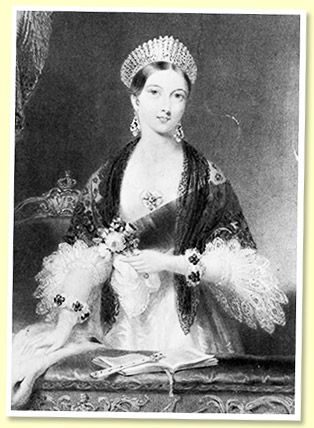
Queen Victoria four years into her reign, when the Blair Castle Whiskey was first bottled in 1841. |
|
|
Then of course, how that origin changed and became distorted as the drink evolved and became taken up by industry. For example, we found these piney and petrichor notes impossible to disassociate in our minds from the landscape of Perthshire. But then, how do we square that with the undeniable coastal notes we detected, what alchemy even creates such a profile, and what has happened to the chemistry of this whisky during the nearly two centuries since the time of its creation? It's well worth noting that the chemical analysis did not detect any phenolic signatures we would associate with peat, so where are these medicinal aspects arising from? It also speaks to the fact that, being distilled in Perthshire, they would likely have had less requirement to use peat as a fuel source for drying, with coal and wood being more readily available. Does that again lead us to think about ideas of terroir? The physical realities of land guiding the actions of the producers? |
|
|
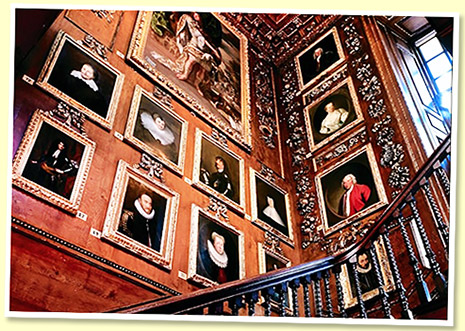
|
|
| Blair Castle |
|
This is the third (and hopefully not the final) time I am tasting this whisky. For me, personally, I find it profoundly comforting that something so familiar, yet decisively high quality and built around distillate character, would have resulted from what is very likely historic, illicit pot still distillation. It's also remarkable that, had I been given this blind, I would have said it could have been produced anytime up until around the 1940s/1950s in my estimation. In this way, it changes my perception about eras of production in Scotch whisky, and to think about where the real diving lines are in terms of production styles and shifts in the overarching character of the drink. It only serves to strengthen this idea I touched on in my comments about the Longmorn and the dividing lines of the pre and post war production eras. |
|
|
Finally, this is just one whisky, and we should of course be cautious about drawing too many conclusions about it from a broader historical prospective. I have tried to summarise my thoughts and impressions about the whisky itself, but the key takeaway for me is that it's probably one of the most emotional and historically romantic tasting experiences of my life. I don't mind that it ignites more questions than it answers, I am just very grateful that it exists at all. It is, when all else is said and done, extremely cool! |
|
|
Angus SGP: 563 - 92 points.
Serge SGP:563 – 93 points. |
|
|
 |
Unknown believed 19th century Irish Whiskey (Circa 55%) 
From a stash of bottles discovered in an old outbuilding in Ireland and brought to auction at Whisky Online back in 2020. Some chemical analysis was also apparently done on these and suggested a mixed grain whisky with malt base, pot distilled and aged in oak. Although, it seems likely that the many bottles of this which were discovered (over 100 apparently) were in wildly varying condition, so if you find another bottle this note could prove pretty useless I'm afraid. Colour: white wine. Nose: once again, obviously something ancient, however, here there is also something slightly more funky and acetic going on, an aroma that would point towards bacterial activity perhaps? With these impressions of lactic acid, cheese rind and then big fat notes of shoe polish, suet and marrow. It shares something of the Blair Castle's power and fatness, while also being definitely 'weirder'. A little camphor and petrolic character too. With water: really magnifying these acetic notes now, going into lemon yoghurt, goat cheese and white wine vinegar. Sounds unpleasant, but it's actually very funny and pretty fascinating. In time a little green herbal note and some dried mint appear. |
|
|
Mouth: you have to wonder what kind of chemistry you are ingesting here. Globally this is a thinner spirit, and I wouldn't be surprised if it is a mixed mash bill indeed. More syrupy, thinner in flavour and actually a little sweeter and grassier. Also funny bacterial notes and impressions of plasticine, malt vinegar and slightly sour cereals. I would say there are some technical flaws in this as compared to the Blair Castle. With water: green apples, tart lemons and citric acidity, lemongrass and miso paste. I actually find it improves quite a bit here with just three drops of water. Really doubling down on these crisp, tart green apple notes and becoming more refreshing. I would add two more points here just because of the reduced palate. |
|
|
Finish: good length, back on cereals, apples again but rather funkier wee cider apples now, also more grassiness, that persistent acetic note and perhaps some spirituous qualities such as turpentine or paraffin. |
|
|
Comments: Not as technically impressive or a pleasurable as the Blair Castle. But this is still historically fascinating and a hugely impressive liquid relic. I would say the variation in ingredients is clearly betrayed by the texture and character of the spirit, and I think something rather more funky may have occurred during fermentation - or possibly it's storage history, which is definitely not up to the same consistency or care as the Blair Castle enjoyed. What I really enjoy is that it clearly ticks some similar boxes as the Blair Castle: young, lightly oak matured and highly distillate driven. |
|
|
Angus SGP: 561 - 83 points.
Serge SGP:561 – 83 points. |
|
|
(Heartfelt thanks and hugs to Iain and Gunner.) |
|
|
|
|
| |
|
|
|
|
|
|

